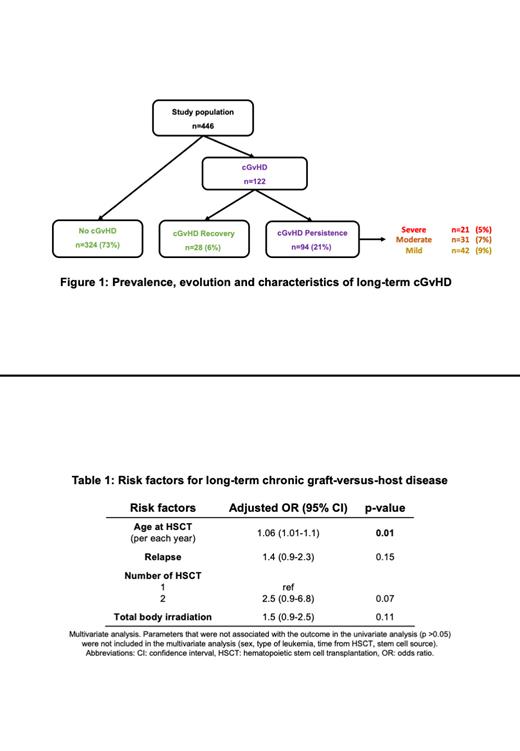Introduction: Hematopoietic stem cell transplantation (HSCT) remains a key treatment of high-risk childhood leukemia despite a wide range of long-term complications. Chronic graft-versus-host disease (cGvHD) is a severe complication of HSCT characterized by the immune response of transplanted cells against the recipient's organs. Adults undergoing HSCT are particularly susceptible to experiencing cGvHD. This complication is generally considered to be much less common when HSCT is performed during childhood and adolescence, though very limited long-term data is available. The present study from the LEA program aims to provide a better understanding of cGvHD and its long-term impact in long-term childhood leukemia survivors.
Methods: LEA is a long-term follow-up program involving all childhood acute leukemia survivors treated in the French participating centers since 1980 (clinicaltrials.gov identifier: NCT01756599). The patients eligible to the present study were all patients included in the LEA cohort treated with HSCT. The primary objective of this cross-sectional study was to provide a long-term and comprehensive cGvHD evaluation in childhood leukemia survivors. Secondary objectives included identifying risk factors for cGvHD, assessing the impact of the disease on quality of life (QoL), and evaluating its evolution over time. The long-term cGvHD data were generated during an in-person dedicated follow-up visit by a clinician using 1) a dedicated questionnaire, and 2) the eGVHD application (UZ Leuven, Belgium) for standardizing the evaluation. QoL was evaluated using the SF36 questionnaire.
Results: The study included a cohort of 446 patients treated for acute lymphoblastic leukemia (59%), acute myeloid leukemia (34%), or another hematological malignancy (7%). The age at HSCT was 8.9 ±0.3 years (mean ±standard error of mean). The dedicated long-term evaluation of cGvHD was performed 8.8 ±0.3 years after HSCT. The stem cell source was matched sibling donor (32%), mismatched related donor (9%), unrelated donor (37%), and cord blood (22%). HSCT was performed in first complete remission in 47% of patients. Myeloablative conditioning and total body irradiation were administered to 91% and 56% of patients, respectively. Anti-thymocyte globulin and ciclosporin were given to 49% and 94% of patients, respectively. At the time of the study, most patients never experienced (n=324, 73%) or recovered (n=28, 6%) from cGvHD. However, a significant proportion of patients (n=94, 21%) suffered long-term cGvHD of variable severity (45% mild, 33% moderate, and 22% severe) (Figure 1). Patients mostly had isolated organ defects (most frequently skin, eyes, and mouth defects). Multiple organs defects were also reported in some patients without recurrent patterns. At the time of cGvHD evaluation, patients suffering cGvHD mostly remained untreated (83%, n=78). Systemic treatment (ruxolitinib, ciclosporine, ibrutinib, and sirolimus), as well as local treatment were used in 11% and 5% of patients, respectively. cGvHD was significantly associated with several other long-term complications (thyroid function defects, cataract, lung function defects, osteonecrosis, diabetes). In a multivariate analysis (Table 1), age at HSCT was significantly associated with long-term cGvHD (odds ratio 1.06 for each additional year, 95% confidence interval 1.01-1.1, p=0.01). Sex, type of leukemia, time from HSCT, stem cell source, relapse, number of HSCT and total body irradiation were not significantly associated with long-term cGvHD risk. Long-term cGvHD had a marked detrimental effect on QoL, even after adjusting to the total number of other long-term complications. The physical and psychic SF36 adjusted composite scores in patients with versus without cGvHD were 50 ±1.5 versus 55 ±0.7 (p=0.01) and 38 ±1.9 versus 43 ±1.0 (p=0.01), respectively.
Conclusion: This study shows that cGvHD is a frequent and severe complication in long-term survivors of childhood leukemia treated with HSCT. Higher age at HSCT is the main risk factor for long-term cGVHD in this population. Long-term cGvHD significantly and independently jeopardizes the survivors' QoL. This complication is probably underrecognized and undertreated. There is a great need for a systematic and standardized cGvHD evaluation in this population.
Disclosures
Baruchel:Servier: Honoraria, Research Funding; AstraZeneca: Other: honoraria for advisory board participation but given to my institution; Clinigen: Honoraria; Serb: Other: honoraria for advisory board participation; Jazz: Other: honoraria for advisory board participation. Dalle:Jazz Pharmaceuticals: Honoraria.


This feature is available to Subscribers Only
Sign In or Create an Account Close Modal